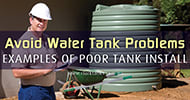Correct preparation and installation helps to ensure a long and hassle-free life of your poly water tank. The majority of claims made on poly water tanks are due to incorrect installation or misuse.
Many problems could have been avoided if the tank owner adhered to the instruction manual that gets provided with each tank. This article explores some common ways poly tanks have been badly installed or abused throughout Clark Tanks’ two decades of manufacturing.
Please don’t make the same mistakes others have made. We will always honour our tank warranties where conditions have been met, but it is obviously an unpleasant situation when there is evidence of misuse or bad installation.
Tank Misuse or Abuse
- Climbing on top of your tank – sometimes when connecting pipework or getting up on a roof people are tempted to jump on top of their tank. Tanks are designed to hold water, not to withstand the weight of a person walking on top of them. Doing this can lead to the top of your poly tank caving in so don’t do it.
- Lack of man power – water tanks can be quite heavy and so it is important you have enough people power to help unload and move your tank into place. Clark Tanks recommend customers have adequate manpower onsite to assist:
- 9,092L – 13,638L: 1 person required onsite at time of delivery (2 total)
- 22,730L: 2 people required onsite at time of delivery (3 total)
- 23,640L – 31,823L: 3 people required onsite at time of delivery (4 total)
- 36,369L – 46,824L: 4 people required onsite at time of delivery (5 total)
- Failure to secure tank – it is essential upon delivery of your tank that you immediately fill it with 2.5cm of water to properly secure it from being blown over and damaged.
- Moving a tank that isn’t empty– when moving your tank, it is important that you ensure it is empty. Moving a tank with water isn’t just heavy, but can exert enormous pressure on the base and walls.
Poor Tank Base or Foundations
- Uneven and soft surfaces – for example, rocky and uneven ground with little preparation can undermine the base or cause sharp objects to damage or even protrude your tank (keep in mind that 1000 litres of water weighs a tonne!)
- Poor deck bases – timber sleepers, bricks or corrugated iron are unstable and should not be used under any circumstances. These are unstable and may stress the tank causing it to fail. deck bases formed from timber sleepers, bricks or corrugated iron are unstable and can cause additional stresses resulting in tank failure.
- Incorrect slab thickness or material – poly tanks need to be placed on compacted crusher dust or reinforced concrete that is 100mm in thickness (150mm thick if greater than 36,000L)
- Incorrect slab diameter – all bases should be at least 200mm greater than the diameter of the tank (100mm space all around the tank)
- No base retainer – over time the tank base can be eroded causing the foundation to become sloped or unstable. To prevent this happening an adequate retainment should be considered for the base.
Poor Tank Installation
- Solid tank foundations – just covered, they are crucial to maintaining the structural integrity of your tank.
- Lack support for connecting pipes – pipes leading from your tank overflow and outlet should be fully support without relying upon your tank’s structure. Unsupported pipework causes excessive strain on fittings and tank wall.
- No flexible joiner from tank outlet to pipework – a short 300mm flexible rubber hose from your tank outlet/valve to plastic pipework will help absorb any shocks and movement preventing broken fittings.
- Tank overflow pipes – need to lead water away from tank or your tank’s foundations can be undermined.
It is important to note that Clark Tanks’ poly tanks are manufactured in Australia to be some of the strongest on the market. They are made to exceed the Australian Standard for poly tanks, AS/NZS 4766 Polyethylene storage tanks for water and chemicals, which ensures that a poly tank is capable of containing water, liquids for food and beverage manufacture and chemical solutions at atmospheric pressure. Nonetheless, they still require proper care.
Many problems that arise can be avoided with correct site preparation, tank installation and care. Installation instructions included with tanks are there to prevent many of the above issues from happening. Every rainwater tank sold should have them included.
